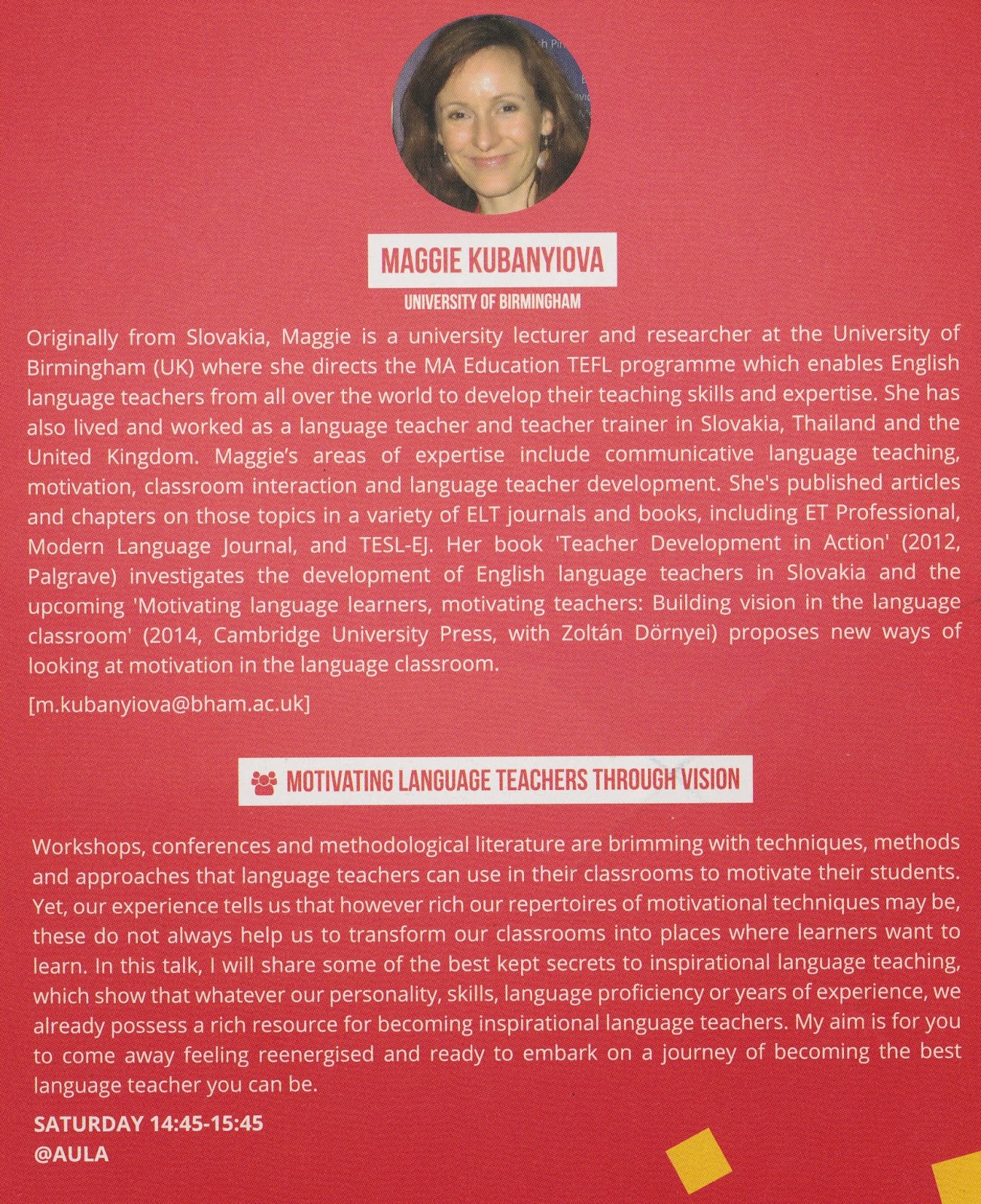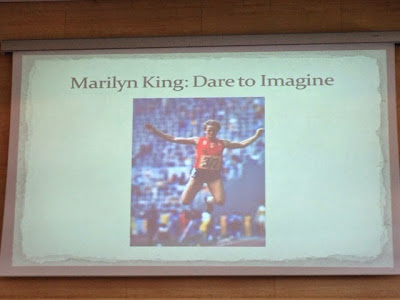The closing plenary session for ELT Forum was given by Maggie Kubanyiová.
Her bio and description are shown above but briefly: she is a lecturer and researcher at the University of Birmingham (where I am doing my MA TEFL/TESL) who focuses on learner motivation. She recently co-authored the book Motivating Learners, Motivating Teachers for the Cambridge Language Teaching Library Collection with Zoltán Dörnyei. Her talk promises to share some of the best kept secrets to inspirational language teaching which take advantage of teachers' inherent personalities, knowledge and skill sets.
She begins her talk by thanking the conference organizers and commenting on how fantastic all the ideas and activities that have been shared at the conference are. She then brings up a problem that she had heard discussed at many of these talks....motivating learners.
She shares a quote from a secondary school teacher who struggled with this very issue.
Essentially, although we embrace the ideas on motivation, the evidence doesn't come through in the classroom. The reason being that it makes sense and seems wonderful in the training session, but once you're back at home and back at work it just seems more comfortable and clearer to do things the old way.
This happens to varying degrees to most of us, and her question was to find out why this was. Her answer draws inspiration from T.S. Eliot.
So, the question is how do we take these ideas from training sessions and make them ours; make them personal and real for our own lives?
She refers to second language acquisition (SLA) research questions posed by Rod Ellis:
She focuses primarily on the green question in her own research. Seeking to find how what teachers already know and do affect the theories in SLA. To seek a connection between research and classroom practice.
For a bit of background she defines "language teacher cognition" as the following collection of issues.
The collection if things which inform our teaching and what we see as best practice. It comes down to how we see ourselves and what vision we have of ourselves in the future. As we realize this we start to make more conscious decisions about the future.
Another definition she gives for "ideal language teacherselves" which is who we would like to become. The reality we want to create for ourselves as developing professionals.
An ideal self is not something simple like "I would like to be a good teacher", but something vivid and real with details about all the variety of factors that affect our motivation and actions.
An example she gives relates directly to our situation as conference attendees. She says that what we pay attention to and what we ignore, that is, the way we engage with the ideas at this conference - that is how we see our future selves.
In actual practice we look at some specific questions:
Who are we? Why do we do this? and What is the image we have of our future selves?
Starting with "Who are we?", she gives the example of Benjamin Zander, the famous orchestral conductor.
She tells us "the conductor of the orchestra doesn't make a sound". He is on the cover of the CD and yet we never hear him make a sound.
We as teachers act in much the same way. When we're doing our job at its best, we simply direct and guide our students, and it is what comes out of their mouths and pens that matters in the end.
This is how she sees her own teaching. If her students' eyes are not shining, then what she as the teacher is doing hasn't connect with them.
She shares the above Palmer quote to drive the message home that it is really "WHO am I being" that matters for this motivational factor, with teaching ability and technique a requisite, but not standalone factor.
She draws our attention to the first activity on the handout (to be attached via scribd later) which focuses on finding our own gifts and passions; the things we are good at. She gives examples of colleagues who juggle in class, discuss music, dance - whatever impassions them and drives the inspirational aspect to their teaching.
The next part if her talk asks us to think of a teacher who inspired us. We work in pairs to describe who it was (for me, it was my biology teacher Mr. Campbell who I thought of because of his offhand and sarcastic style which made him much more authentic as a person than other teachers I had at the time).
Her follow up task was to think about what it was about us (not the teacher) that made this teacher inspirational. In this case I can look back at 15 year old me and remember the fact that I appreciated being treated like an adult and so I responded to Mr. Campbell's style because it came across as genuine, friendly and at times mocking, which seemed a much more genuine interaction than other teachers I had at the time. I look back at other teachers I remember as being important to me at the time: Mrs. Ralston (French), Mr. Hohl (Math), Mr. Dober (Physics) and I realize that though they were vastly different from each other, all of them stick out in my mind as being good teachers, and as being adults who treated me as an adult at a time when other teachers still treated me like a child.
She asks us to look at these inspirational teachers and not seek lessons on how to teach like them, but rather to look at what that experience says about us.
The next question she asks is the why. That is, why we think language is important.
The above response was given to Kubanyiová at the end of a training on motivating students. She found it useful because it made her realize this idea of motivation is not always an obvious or easy thing to train.
She then talks about what things language teachers need to know. Basing it on the "Golden Circle" for language teachers.
Knowing the "What"s like: present perfect, articles, conditionals isn't enough.
Knowing the "How"s like: how to set up a listening task, how to get students speaking isn't enough.
Knowing the "why"s of our teaching are also necessary when we look for motivation. Why are we doing this? Why is this important?
She gives an example dialogue from a communicative teaching methodologies session. T is the teacher and S is the student.
The issue here is why did we do the first task? Students did this, and in the end what students came up with was of no value to the teacher because it was irrelevant to the task. So why do this task? We need to consider the tasks we ask of our students and what they mean to our learners and how they connect to other elements of class. Most importantly, remembering to acknowledge student ideas and contributions so they have a purpose.
Her final section deals with the image.
We are asked to close our eyes and imagine a big yellow lemon, smell it, we have a knife in our hand and we want to cut that lemon in half. Now we can smell it even more clearly. We can bring it up to our face and lick it. We can taste the tartness of the juice in our mouth.
We come back and realize that many of us are salivating and that imagination is actually quote powerful.
This is how image and imagination factor into teaching and professional development in motivation.
She gives and example then of a successful athlete who has been quoted as saying that imagining herself walking into the Olympic stadium was the image that got her up for 5 a.m. trainings and through grueling drills and practice. Images like these give us the power to overcome all sorts of obstacles in our professional lives. They give us direction and inspiration.
The task then is to imagine and take a tour around our ideal classroom. Look around and see what is happening and think about getting ourselves there. I missed the change to grab a picture of the slide (too busy typing the previous sentence), but it was full of wonderful images of smiling students and teachers, round table discussions, etc etc.
She concludes her talk with a story:
A little boy was watching this man in the middle of the square. There was sweltering heat and this man was working very hard and chopping away with a chisel at a piece of large stone. The boy looked at the man and wondered what he was doing. "Why are you doing that? It doesn't make any sense." And Michaelanglo said this "See little boy, there's an angel inside and I want to make him free.


















No comments:
Post a Comment